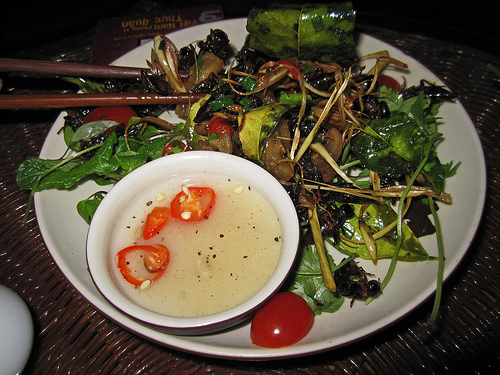By Melissa Spady (The Cascade) – Email
Print Edition: July 17, 2013
If my mother saw this article, she’d probably laugh hysterically in disbelief.
As a child I was an extremely picky eater and during my teen years I wasn’t much better at adapting to new tastes or textures. But I’ve found since becoming a 20-something, my taste buds have finally decided to broaden their horizons. I first heard about Entomophagy (or the act of humans eating insects) on a local radio station where one of the hosts turned his nose up at the thought. His reaction echoes many other Westerners. As it turns out, we have two restaurants in Vancouver that serve a bug inspired dish. Vij’s Restaurant features a paratha (South Asian flat bread) with flour made of roasted ground crickets and Rangoli Restaurant’s menu has a naan bread pizza with whole roasted crickets as a topping. I plan on letting my own taste buds test bot.
Vancouver is a trend-setting city known for being a little daring. But beyond the cool factor, could eating insects help sustainably end starvation around the globe?
The United Nations say yes!
It is widely accepted amongst experts that by the year 2050 there will be close to nine billion people on our planet, and with one billion already starving worldwide, we need to pay serious attention to how we can expect to feed all these people if we’re already struggling. In “Edible Insects,” a 200-page report published this May, the U.N. estimates that roughly two billion people currently incorporate insects into their diet. Although nutritional value varies by species, some insects are a good source of protein, and have high fat, fibre and mineral content. According to the report, crickets rate highest in their nutritional yield. For every 100 grams of cricket you ingest you’re getting 121 calories, 12.9 grams of protein, 5.5 grams of fat, 5.1 grams of carbohydrates, 75.8 milligrams of calcium and more. Other benefits include the ability to process their food into body weight more efficiently than traditional livestock. Research also indicates they leave a much smaller carbon footprint.
There is no downside large enough to derail giving it a shot; however I can almost hear some readers cringing at the thought of having crickets on their pizza or incorporating worms into their stir-fry. Over 80 per cent of the world’s countries eat insects on a regular basis, and yet most of us here squeal in agony when an ant crawls on our arm. The truth is that we have enough food on the planet right now to feed everyone, but the ratios of distribution are grossly out of proportion.
This point is often over-looked when discussing hunger and starvation. I think it’s awesome and completely necessary to look for a new, sustainable way to feed the growing population, but where is the justice in hoarding food? (I’m looking at you North America!) Sure, we could all donate to World Vision and feed hungry children, there are certainly worse things to do to end world hunger. However, the problem is largely the attitude of those in the first world rather the existence of a viable solution.
When you go home, stare into your full cupboards, and complain that there’s “nothing to eat,” you truly ought to be smacked for acting so spoiled. I really feel that those who scoff at an option to feed people just because it’s different from their own diet, or think its “gross,” need to re-evaluate their priorities, especially if they’ve never tried it themselves. We have thousands of different food choices every single day, but because you don’t see chocolate covered ants as a snack, suddenly it doesn’t qualify as a meal?
We have a solution, it just seems so outlandish to some that it’s going to take a while to get it off the ground.


